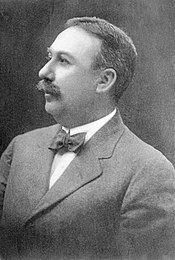Edwin S. Porter
| Edwin Stanton Porter | |
|---|---|

Edwin Stanton Porter, 1901 photo
|
|
| Born |
April 21, 1870 Connellsville, Pennsylvania |
| Died | April 30, 1941 (aged 71) New York City, New York |
| Occupation | Film director, film producer |
| Parent(s) | Thomas Richard Porter Mary Clark |
|
|
Edwin Stanton Porter (April 21, 1870 – April 30, 1941) was an American film pioneer, most famous as a producer, director, studio manager and cinematographer with the Edison Manufacturing Company and the Famous Players Film Company. Of over 250 films created by Porter, his most important include Jack and the Beanstalk (1902), Life of an American Fireman (1903), The Great Train Robbery (1903), The Kleptomaniac (1905), Life of a Cowboy (1906), Rescued from an Eagle's Nest (1908), and The Prisoner of Zenda (1913) .
Porter was born and raised in Connellsville, Pennsylvania to Thomas Richard Porter, a merchant, and Mary (Clark) Porter; he was the fourth of seven children with four brothers (Charles W., Frank, John and Everett Melbourne) and two sisters (Mary and Ada). Named Edward at birth, he later changed his name to Edwin Stanton, after the Democratic politician from Ohio who had served as Abraham Lincoln's Secretary of War. After attending public schools in Connellsville, Porter worked, among other odd jobs, as an exhibition skater, a sign painter, and a telegraph operator. He developed an interest in electricity at a young age, and shared a patent at age 21 for a lamp regulator. Eventually becoming a merchant tailor, Porter was battered by the 1893 financial panic. He filed for bankruptcy on June 15 and enlisted in the United States Navy four days later on June 19.
He was employed initially in the electrical department of William Cramp & Sons, a Philadelphia ship and engine building company. During his three years' service he showed aptitude as an inventor of electrical devices to improve communications.
Porter entered motion picture work in 1896, the first year movies were commercially projected on large screens in the United States. He was briefly employed in New York City by Raff & Gammon, agents for the films and viewing equipment made by Thomas Edison, and then left to become a touring projectionist with a competing machine, Kuhn & Webster's Projectorscope. He traveled through the West Indies and South America, showing films at fairgrounds and in open fields, and later made a second tour through Canada and the United States.
...
Wikipedia
